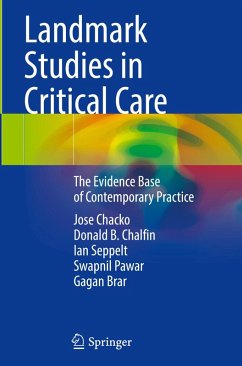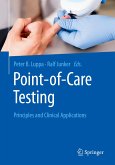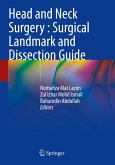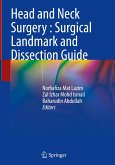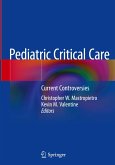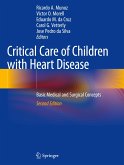Jose Chacko, Donald B. Chalfin, Ian Seppelt
Landmark Studies in Critical Care
The Evidence Base of Contemporary Practice
Jose Chacko, Donald B. Chalfin, Ian Seppelt
Landmark Studies in Critical Care
The Evidence Base of Contemporary Practice
- Gebundenes Buch
- Merkliste
- Auf die Merkliste
- Bewerten Bewerten
- Teilen
- Produkt teilen
- Produkterinnerung
- Produkterinnerung
The book is a curated collection of groundbreaking papers entrenched in evidence-based medicine to provide trainees and practitioners in critical care medicine with a handy tool for reference. This compilation highlights pivotal research papers that have significantly influenced clinical practice. The studies in this book are carefully selected based on a rigorous methodology and cover a wide range of critical topics. The studies present robust findings and offer guidance on improving clinical outcomes.
Critical care medicine is a relatively new area of specialization and many contentious…mehr
Andere Kunden interessierten sich auch für
![Point-of-care testing Point-of-care testing]() Point-of-care testing113,99 €
Point-of-care testing113,99 €![Textbook of Neuroanesthesia and Neurocritical Care Textbook of Neuroanesthesia and Neurocritical Care]() Textbook of Neuroanesthesia and Neurocritical Care137,99 €
Textbook of Neuroanesthesia and Neurocritical Care137,99 €![Head and Neck Surgery : Surgical Landmark and Dissection Guide Head and Neck Surgery : Surgical Landmark and Dissection Guide]() Head and Neck Surgery : Surgical Landmark and Dissection Guide105,99 €
Head and Neck Surgery : Surgical Landmark and Dissection Guide105,99 €![Head and Neck Surgery : Surgical Landmark and Dissection Guide Head and Neck Surgery : Surgical Landmark and Dissection Guide]() Head and Neck Surgery : Surgical Landmark and Dissection Guide149,99 €
Head and Neck Surgery : Surgical Landmark and Dissection Guide149,99 €![Pediatric Critical Care Pediatric Critical Care]() Pediatric Critical Care98,99 €
Pediatric Critical Care98,99 €![Critical Care of Children with Heart Disease Critical Care of Children with Heart Disease]() Critical Care of Children with Heart Disease152,99 €
Critical Care of Children with Heart Disease152,99 €![Traumatic Brain Injury Traumatic Brain Injury]() Traumatic Brain Injury130,99 €
Traumatic Brain Injury130,99 €-
-
-
The book is a curated collection of groundbreaking papers entrenched in evidence-based medicine to provide trainees and practitioners in critical care medicine with a handy tool for reference. This compilation highlights pivotal research papers that have significantly influenced clinical practice. The studies in this book are carefully selected based on a rigorous methodology and cover a wide range of critical topics. The studies present robust findings and offer guidance on improving clinical outcomes.
Critical care medicine is a relatively new area of specialization and many contentious topics have been the focus of research over the years. In the contemporary era of evidence-based medicine, researchers continue to search for reliable evidence. Despite an abundance of research, few papers have truly shaped the landscape. The book presents an overview of critical care research that has significantly influenced the field and impacted clinical practice. These studies represent landmarks in the history of critical care medicine, spearheaded by leaders in their research.
The book is designed to appeal to both trainees and practitioners in the field of critical care medicine.
Critical care medicine is a relatively new area of specialization and many contentious topics have been the focus of research over the years. In the contemporary era of evidence-based medicine, researchers continue to search for reliable evidence. Despite an abundance of research, few papers have truly shaped the landscape. The book presents an overview of critical care research that has significantly influenced the field and impacted clinical practice. These studies represent landmarks in the history of critical care medicine, spearheaded by leaders in their research.
The book is designed to appeal to both trainees and practitioners in the field of critical care medicine.
Produktdetails
- Produktdetails
- Verlag: Springer / Springer Nature Singapore / Springer, Berlin
- Artikelnr. des Verlages: 89519579, 978-981-95-0672-9
- Seitenzahl: 708
- Erscheinungstermin: 27. September 2025
- Englisch
- Abmessung: 241mm x 160mm x 41mm
- Gewicht: 1341g
- ISBN-13: 9789819506729
- ISBN-10: 9819506727
- Artikelnr.: 74741580
- Herstellerkennzeichnung
- Springer-Verlag KG
- Sachsenplatz 4-6
- 1201 Wien, AT
- ProductSafety@springernature.com
- Verlag: Springer / Springer Nature Singapore / Springer, Berlin
- Artikelnr. des Verlages: 89519579, 978-981-95-0672-9
- Seitenzahl: 708
- Erscheinungstermin: 27. September 2025
- Englisch
- Abmessung: 241mm x 160mm x 41mm
- Gewicht: 1341g
- ISBN-13: 9789819506729
- ISBN-10: 9819506727
- Artikelnr.: 74741580
- Herstellerkennzeichnung
- Springer-Verlag KG
- Sachsenplatz 4-6
- 1201 Wien, AT
- ProductSafety@springernature.com
Dr. Jose Chacko, MD, DA, DNB, EDIC, MBA, graduated in medicine and completed post-graduation in anesthesia from Medical College, Trivandrum, India. He underwent advanced training in critical care medicine from leading hospitals in Australia and worked as a consultant in anesthesia and critical care with the National Health Services in the United Kingdom. He has completed the European Diploma in Intensive Care (EDIC) from the European Society of Intensive Care Medicine (ESICM) and currently works as a senior consultant in critical care medicine at Narayana Health, Bangalore, India. A renowned teacher and academician, he is a leading practitioner and teacher of critical care medicine in India. He has many publications in peer-reviewed journals and contributed to text books in critical care and emergency medicine. He contributes regularly to academic meetings in critical care medicine. Dr. Chacko runs a blog site (criticalcareblogspot.com) and creates podcasts (critcareedu.com.au) that address provocative topics in critical care medicine. Dr. Swapnil Pawar, MD, FCICM, EDIC, completed his post-graduation in anesthesia in 2010 from the Post Graduate Institute of Medical Education and Research (PGIMER), Chandigarh, India. He is a fellow of the College of Intensive Care Medicine (FCICM), Australia and New Zealand and has also completed his European Diploma in Intensive Care (EDIC) with the European Society of Intensive Care Medicine (ESICM). He is currently working as a consultant intensivist at the St. George Hospital in Sydney and is the coordinator for Innovation in Intensive Care. He is the chair of the education committee of the Australia and New Zealand Intensive Care Society (ANZICS). He has a keen interest in simulation and medical education and is a certified simulation healthcare educator (CHSE) with the Society of Simulation in Healthcare (SSH). He is the host and producer of six educational podcast series andruns his educational website Critical Care Education (www.critcareedu.com.au). He is currently pursuing his Ph.D. in the field of cognitive load theory and has delivered numerous oral and posters presentations at international meetings. He is a trained mediator and enjoys grooming young talent as a captain of St George district cricket club metro team. Professor Ian Seppelt, FANZCA, FCICM, graduated in medicine from the University of Sydney, Australia. He is a senior specialist in intensive care medicine at Nepean Hospital, University of Sydney, professor of anesthesia at Macquarie University, and professorial fellow at The George Institute for Global Health, Sydney. He has more than 100 peer-reviewed international publications and has delivered numerous invited presentations at international meetings. He is a past executive member of the ANZICS Clinical Trials Group and lead investigator for SuDDICU (Australia) for which he received a National Health and Medical Research Council Research Excellence Award in 2015. He is on the management committees for several clinical trials including SuDDICU, SPICE-IV, and REMAP-CAP. He chairs the Nepean Blue Mountains Local Health District Human Research Ethics Committee (HREC) and is a member of various data safety monitoring boards. He is a medical advisor to Equestrian Australia and assistant groom and transport technician for his wife and children when they are competing. Dr. Gagan Brar, MD, DNB, EDIC, IDCCM, graduated in medicine and completed post-graduation in anesthesia from Kasturba Medical College, Manipal, India. She underwent training in critical care medicine at Manipal Hospital and Fortis Hospital, Bangalore, India. She is a fellow of the National Board of Examinations in critical care medicine and has completed the European diploma in intensive care (EDIC) with the European Society of Intensive Care Medicine (ESICM). She currently works as a consultant in critical care medicine, Aster RV Hospital,
Part I: Mechanical Ventilation and Respiratory Failure.- 1. Neuromuscular Blockers in Acute Respiratory Distress Syndrome: The ACURASYS Trial.-2. Ventilation with Low Tidal Volumes in Acute Respiratory Distress Syndrome: The ARDS-Net Trial.- 3. Prone Ventilation in Severe Acute Respiratory Distress Syndrome: The PROSEVA Trial.- 4. Timing of Tracheostomy: Early vs. Late Tracheostomy in Mechanically Ventilated Patients: The TRACMAN Trial.- 5. High-Frequency Oscillation in Acute Respiratory Distress Syndrome: The OSCILLATE Trial.- 6. High-Frequency Oscillation in Acute Respiratory Distress Syndrome: The OSCAR Trial.- 7. Positive End-Expiratory Pressure Setting in Acute Respiratory Distress Syndrome: The EXPRESS Trial.- 8. Comparison of Different Methods of Weaning from Mechanical Ventilation: Esteban et al.- 9. Noninvasive Ventilation for Chronic Obstructive Pulmonary Disease: Brochard et al.- Part II: Fluid Management.- 10. Albumin vs. Normal Saline for Resuscitation: The SAFE Trial.- 11. Albumin Replacement in Severe Sepsis and Septic Shock: The ALBIOS Trial.- 12. Hydroxyethyl Starch vs. Normal Saline for Fluid Resuscitation: The CHEST Trial.- 13. Balanced Crystalloid vs. Normal Saline for Resuscitation: The SMART Trial.- 14. Balanced Crystalloid vs. Normal Saline for Resuscitation: The BaSICS Trial.- 15. Balanced Multielectrolyte Solution vs. Normal Saline for Resuscitation: The PLUS Trial.- 16. Conservative vs. Liberal Fluid Management in ARDS: The FACTT Trial.- Part III: Cardiopulmonary Resuscitation.- 17. Compression-Only Cardiopulmonary Resuscitation in Out-of-Hospital Cardiac Arrest: The DART Trial.- Part IV: Neurosciences.- 18. Intracranial Pressure Monitoring and Outcomes in Traumatic Brain Injury: The BEST-TRIP Trial.- 19. Methylprednisolone in Severe Traumatic Brain Injury: The CRASH Trial.- 20. Thrombectomy at 6 to 24 Hours Following Stroke with Mismatch Between Deficit and Infarct Size: The DAWN Trial.- 21. Decompressive Craniectomy in Severe Diffuse Traumatic Brain Injury: The DECRA Trial.- 22. Decompressive Craniectomy for Intracranial Hypertension Following Traumatic Brain Injury: The RESCUEicp Trial.- 23. Decompressive Craniectomy in Older Patients with Extensive Middle-Cerebral-Artery Stroke: The DESTINY II Trial.- 24. Intravenous Thrombolysis Between 3 4.5 Hours After Stroke: The ECASS 3 Trial.- 25. A Comparison of Four Treatments for Generalized Convulsive Status Epilepticus: Treiman et al.- 26. Neurosurgical Clipping vs. Endovascular Coiling in Ruptured Intracranial Aneurysms: The ISAT Trial.- 27. Tissue Plasminogen Activator for Acute Ischemic Stroke: The NINDS Trial.- 28. Tranexamic Acid in Traumatic Brain Injury: The CRASH-3 Trial.- Part V: Corticosteroids in Sepsis.- 29. Hydrocortisone-Fludrocortisone Combination in Septic Shock: Annane et al.- 30. Hydrocortisone in Septic Shock: The CORTICUS Trial.- 31. Hydrocortisone in Septic Shock: The ADRENAL Trial.- Part VI: Corticosteroids in ARDS.- 32. Methylprednisolone for Unresolving Acute Respiratory Distress Syndrome: Meduri et al.- 33. Corticosteroids in Persistent Acute Respiratory Distress Syndrome: The LAsRS Trial.- Part VII: Nephrology and Renal Replacement Therapy.- 34. Low-Dose Dopamine in Early Renal Dysfunction: The ANZICS Dopamine Trial.- 35. Continuous Venovenous Hemodiafiltration vs. Intermittent Hemodialysis for Acute Kidney Injury in the Critically Ill: The HEMODIAFE Trial.- 36. Timing of Renal Replacement Therapy in Critically Ill Patients with Acute Kidney Injury: The AKIKI Trial.- 37. Comparing Two Delayed Strategies for Renal Replacement Therapy Initiation in Severe Acute Kidney Injury: The AKIKI 2 Trial.- 38. Early vs. Late Initiation of Renal Replacement Therapy in Acute Kidney Injury: The ELAIN Trial.- 39. Timing of Renal Replacement Therapy in Septic Shock with Acute Kidney Injury: The IDEAL-ICU Trial.- 40. Timing of Initiation of Renal Replacement Therapy in Acute Kidney Injury: The STARRT-AKI Trial.- 41. Intensity of Renal Support in Critically Ill Patients with Acute Kidney Injury: The VA/NIH Trial.- Part VIII: Trauma.- 42. Immediate vs. Delayed Resuscitation in Penetrating Torso Injury: Bickell et al.- 43. Tranexamic Acid in Bleeding Trauma Patients: The CRASH-2 Trial.- Part IX: Extracorporeal Support.- 44. Extracorporeal Membrane Oxygenation in Acute Respiratory Failure: The CESAR Trial.- 45. Extracorporeal Membrane Oxygenation in Severe Acute Respiratory Distress Syndrome: The EOLIA Trial.- Part X: Infections.- 46. Duration of Antibiotic Therapy for Ventilator-Associated Pneumonia: The PNEUMA Trial.- 47. Duration of Hypotension Before Effective Antibiotic Therapy and Survival in Septic Shock: Kumar et al.- 48. Diagnostic Techniques for Ventilator-Associated Pneumonia: Canadian Critical Care Trials Group.- 49. Procalcitonin and Antibiotic Exposure in the ICU: The PRORATA Trial.- Part XI: Cardiology, Cardiac Surgery.- 50. Rate vs. Rhythm Control for Atrial Fibrillation Following Post-Cardiac Surgery: The CTSN Trial.- 51. Optimal PCI Strategy in Cardiogenic Shock Following Acute Myocardial Infarction: The CULPRIT-SHOCK Trial.- 52. Coronary Angioplasty vs. Fibrinolytic Therapy in Acute Myocardial Infarction: The DANAMI-2 Trial.- Part XII: Sepsis Resuscitation.- 53. Goal-Directed Resuscitation in Sepsis: The Rivers et al., ProCESS, ARISE, and ProMISe Trials.- 54. Dopamine vs. Norepinephrine in the Treatment of Shock: The SOAP II Trial.- 55. Vasopressin vs. Norepinephrine in Septic Shock: The VAAST Trial.- Part XIII: Nutrition.- 56. Early versus Late Parenteral Nutrition in the Critically Ill: The EPANIC Trial.- 57. Initial Trophic vs. Full Enteral Feeding in Acute Lung Injury: The EDEN Trial.- Part XIV: Therapeutic Hypothermia.- 58. Therapeutic Hypothermia After Out-of-Hospital Cardiac Arrest: The HACA Trial.- 59. Targeted Temperature Management After Cardiac Arrest: 33°C vs. 36°C: The TTM Trial.- 60. Hypothermia or Normothermia After Out-of-Hospital Cardiac Arrest? The TTM 2 Trial.- Part XV: Sedation in the ICU.- 61. Daily Interruption of Sedation in Mechanically Ventilated Patients: Kress et al.- 62. A Combined Sedation and Ventilator Weaning Protocol for Mechanically Ventilated Patients: The ABC Trial.- 63. No Sedation vs. Light Sedation in Mechanically Ventilated Patients: The NONSEDA Trial.- Part XVI: Pulmonary Embolism.- 64. Thrombolysis for Moderate Pulmonary Embolism: The MOPETT Trial.- 65. Fibrinolysis in Intermediate-Risk Pulmonary Embolism: The PEITHO Trial.- 66. Retrievable Inferior Vena Cava Filter Plus Anticoagulation vs. Anticoagulation Alone and Recurrent Pulmonary Embolism: The PREPIC2 Trial.- Part XVII: Glucose Control.- 67. Intensive vs. Conventional Glucose Control in the ICU: The NICE-SUGAR Trial.- 68. Intensive Insulin Therapy in the Surgical ICU: The Leuven 1 Trial.- 69. Intensive Insulin Therapy in the Medical ICU: The Leuven 2 Trial.- Part XVIII: Transfusion Thresholds.- 70. Transfusion Thresholds in the Critically Ill: The TRICC Trial.- 71. Transfusion Thresholds in Septic Shock: The TRISS Trial.- Part XIX: Covid-19 Pneumonia.- 72. Remdesivir for COVID-19 Pneumonia: The ACTT-1 Trial.- 73. Dexamethasone in COVID-19 Infection: The RECOVERY Trial.- Part XX: Miscellaneous.- 74. Acetaminophen for Fever in the Critically Ill: The HEAT Trial.- 75. Step-Up Approach vs. Open Necrosectomy for Acute Necrotizing Pancreatitis: The PANTER Trial.- 76. Intra-aortic Balloon Counterpulsation in Cardiogenic Shock Following Acute Myocardial Infarction: The IABP-SHOCK II Trial.- 77. Pulmonary Artery Catheter in the ICU: The PAC-Man Trial.- 78. Pharmacist Participation on ICU Rounds and Adverse Drug Events: Leape et al.
Part I: Mechanical Ventilation and Respiratory Failure.- 1. Neuromuscular Blockers in Acute Respiratory Distress Syndrome: The ACURASYS Trial.-2. Ventilation with Low Tidal Volumes in Acute Respiratory Distress Syndrome: The ARDS-Net Trial.- 3. Prone Ventilation in Severe Acute Respiratory Distress Syndrome: The PROSEVA Trial.- 4. Timing of Tracheostomy: Early vs. Late Tracheostomy in Mechanically Ventilated Patients: The TRACMAN Trial.- 5. High-Frequency Oscillation in Acute Respiratory Distress Syndrome: The OSCILLATE Trial.- 6. High-Frequency Oscillation in Acute Respiratory Distress Syndrome: The OSCAR Trial.- 7. Positive End-Expiratory Pressure Setting in Acute Respiratory Distress Syndrome: The EXPRESS Trial.- 8. Comparison of Different Methods of Weaning from Mechanical Ventilation: Esteban et al.- 9. Noninvasive Ventilation for Chronic Obstructive Pulmonary Disease: Brochard et al.- Part II: Fluid Management.- 10. Albumin vs. Normal Saline for Resuscitation: The SAFE Trial.- 11. Albumin Replacement in Severe Sepsis and Septic Shock: The ALBIOS Trial.- 12. Hydroxyethyl Starch vs. Normal Saline for Fluid Resuscitation: The CHEST Trial.- 13. Balanced Crystalloid vs. Normal Saline for Resuscitation: The SMART Trial.- 14. Balanced Crystalloid vs. Normal Saline for Resuscitation: The BaSICS Trial.- 15. Balanced Multielectrolyte Solution vs. Normal Saline for Resuscitation: The PLUS Trial.- 16. Conservative vs. Liberal Fluid Management in ARDS: The FACTT Trial.- Part III: Cardiopulmonary Resuscitation.- 17. Compression-Only Cardiopulmonary Resuscitation in Out-of-Hospital Cardiac Arrest: The DART Trial.- Part IV: Neurosciences.- 18. Intracranial Pressure Monitoring and Outcomes in Traumatic Brain Injury: The BEST-TRIP Trial.- 19. Methylprednisolone in Severe Traumatic Brain Injury: The CRASH Trial.- 20. Thrombectomy at 6 to 24 Hours Following Stroke with Mismatch Between Deficit and Infarct Size: The DAWN Trial.- 21. Decompressive Craniectomy in Severe Diffuse Traumatic Brain Injury: The DECRA Trial.- 22. Decompressive Craniectomy for Intracranial Hypertension Following Traumatic Brain Injury: The RESCUEicp Trial.- 23. Decompressive Craniectomy in Older Patients with Extensive Middle-Cerebral-Artery Stroke: The DESTINY II Trial.- 24. Intravenous Thrombolysis Between 3 4.5 Hours After Stroke: The ECASS 3 Trial.- 25. A Comparison of Four Treatments for Generalized Convulsive Status Epilepticus: Treiman et al.- 26. Neurosurgical Clipping vs. Endovascular Coiling in Ruptured Intracranial Aneurysms: The ISAT Trial.- 27. Tissue Plasminogen Activator for Acute Ischemic Stroke: The NINDS Trial.- 28. Tranexamic Acid in Traumatic Brain Injury: The CRASH-3 Trial.- Part V: Corticosteroids in Sepsis.- 29. Hydrocortisone-Fludrocortisone Combination in Septic Shock: Annane et al.- 30. Hydrocortisone in Septic Shock: The CORTICUS Trial.- 31. Hydrocortisone in Septic Shock: The ADRENAL Trial.- Part VI: Corticosteroids in ARDS.- 32. Methylprednisolone for Unresolving Acute Respiratory Distress Syndrome: Meduri et al.- 33. Corticosteroids in Persistent Acute Respiratory Distress Syndrome: The LAsRS Trial.- Part VII: Nephrology and Renal Replacement Therapy.- 34. Low-Dose Dopamine in Early Renal Dysfunction: The ANZICS Dopamine Trial.- 35. Continuous Venovenous Hemodiafiltration vs. Intermittent Hemodialysis for Acute Kidney Injury in the Critically Ill: The HEMODIAFE Trial.- 36. Timing of Renal Replacement Therapy in Critically Ill Patients with Acute Kidney Injury: The AKIKI Trial.- 37. Comparing Two Delayed Strategies for Renal Replacement Therapy Initiation in Severe Acute Kidney Injury: The AKIKI 2 Trial.- 38. Early vs. Late Initiation of Renal Replacement Therapy in Acute Kidney Injury: The ELAIN Trial.- 39. Timing of Renal Replacement Therapy in Septic Shock with Acute Kidney Injury: The IDEAL-ICU Trial.- 40. Timing of Initiation of Renal Replacement Therapy in Acute Kidney Injury: The STARRT-AKI Trial.- 41. Intensity of Renal Support in Critically Ill Patients with Acute Kidney Injury: The VA/NIH Trial.- Part VIII: Trauma.- 42. Immediate vs. Delayed Resuscitation in Penetrating Torso Injury: Bickell et al.- 43. Tranexamic Acid in Bleeding Trauma Patients: The CRASH-2 Trial.- Part IX: Extracorporeal Support.- 44. Extracorporeal Membrane Oxygenation in Acute Respiratory Failure: The CESAR Trial.- 45. Extracorporeal Membrane Oxygenation in Severe Acute Respiratory Distress Syndrome: The EOLIA Trial.- Part X: Infections.- 46. Duration of Antibiotic Therapy for Ventilator-Associated Pneumonia: The PNEUMA Trial.- 47. Duration of Hypotension Before Effective Antibiotic Therapy and Survival in Septic Shock: Kumar et al.- 48. Diagnostic Techniques for Ventilator-Associated Pneumonia: Canadian Critical Care Trials Group.- 49. Procalcitonin and Antibiotic Exposure in the ICU: The PRORATA Trial.- Part XI: Cardiology, Cardiac Surgery.- 50. Rate vs. Rhythm Control for Atrial Fibrillation Following Post-Cardiac Surgery: The CTSN Trial.- 51. Optimal PCI Strategy in Cardiogenic Shock Following Acute Myocardial Infarction: The CULPRIT-SHOCK Trial.- 52. Coronary Angioplasty vs. Fibrinolytic Therapy in Acute Myocardial Infarction: The DANAMI-2 Trial.- Part XII: Sepsis Resuscitation.- 53. Goal-Directed Resuscitation in Sepsis: The Rivers et al., ProCESS, ARISE, and ProMISe Trials.- 54. Dopamine vs. Norepinephrine in the Treatment of Shock: The SOAP II Trial.- 55. Vasopressin vs. Norepinephrine in Septic Shock: The VAAST Trial.- Part XIII: Nutrition.- 56. Early versus Late Parenteral Nutrition in the Critically Ill: The EPANIC Trial.- 57. Initial Trophic vs. Full Enteral Feeding in Acute Lung Injury: The EDEN Trial.- Part XIV: Therapeutic Hypothermia.- 58. Therapeutic Hypothermia After Out-of-Hospital Cardiac Arrest: The HACA Trial.- 59. Targeted Temperature Management After Cardiac Arrest: 33°C vs. 36°C: The TTM Trial.- 60. Hypothermia or Normothermia After Out-of-Hospital Cardiac Arrest? The TTM 2 Trial.- Part XV: Sedation in the ICU.- 61. Daily Interruption of Sedation in Mechanically Ventilated Patients: Kress et al.- 62. A Combined Sedation and Ventilator Weaning Protocol for Mechanically Ventilated Patients: The ABC Trial.- 63. No Sedation vs. Light Sedation in Mechanically Ventilated Patients: The NONSEDA Trial.- Part XVI: Pulmonary Embolism.- 64. Thrombolysis for Moderate Pulmonary Embolism: The MOPETT Trial.- 65. Fibrinolysis in Intermediate-Risk Pulmonary Embolism: The PEITHO Trial.- 66. Retrievable Inferior Vena Cava Filter Plus Anticoagulation vs. Anticoagulation Alone and Recurrent Pulmonary Embolism: The PREPIC2 Trial.- Part XVII: Glucose Control.- 67. Intensive vs. Conventional Glucose Control in the ICU: The NICE-SUGAR Trial.- 68. Intensive Insulin Therapy in the Surgical ICU: The Leuven 1 Trial.- 69. Intensive Insulin Therapy in the Medical ICU: The Leuven 2 Trial.- Part XVIII: Transfusion Thresholds.- 70. Transfusion Thresholds in the Critically Ill: The TRICC Trial.- 71. Transfusion Thresholds in Septic Shock: The TRISS Trial.- Part XIX: Covid-19 Pneumonia.- 72. Remdesivir for COVID-19 Pneumonia: The ACTT-1 Trial.- 73. Dexamethasone in COVID-19 Infection: The RECOVERY Trial.- Part XX: Miscellaneous.- 74. Acetaminophen for Fever in the Critically Ill: The HEAT Trial.- 75. Step-Up Approach vs. Open Necrosectomy for Acute Necrotizing Pancreatitis: The PANTER Trial.- 76. Intra-aortic Balloon Counterpulsation in Cardiogenic Shock Following Acute Myocardial Infarction: The IABP-SHOCK II Trial.- 77. Pulmonary Artery Catheter in the ICU: The PAC-Man Trial.- 78. Pharmacist Participation on ICU Rounds and Adverse Drug Events: Leape et al.

